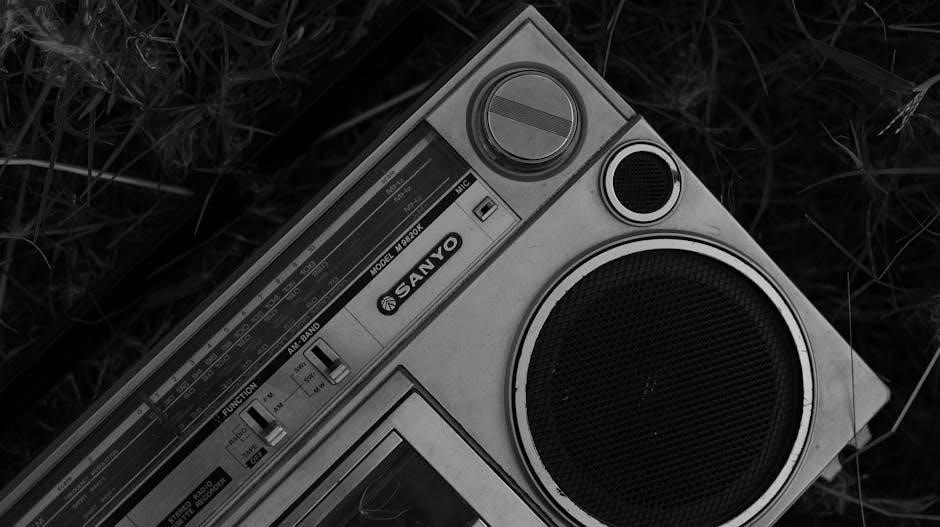The BOSS TU-3 Chromatic Tuner is a high-quality pedal tuner designed for precision and ease of use․ Its comprehensive manual provides essential guidance for optimal performance‚ covering setup‚ features‚ and troubleshooting․ This article explores the TU-3’s capabilities‚ ensuring musicians can unlock its full potential․
Overview of the Boss TU-3 Chromatic Tuner
The Boss TU-3 Chromatic Tuner is a high-quality pedal tuner designed for precision and reliability․ It offers chromatic tuning‚ an LED display‚ and a durable‚ compact design․ Popular among musicians‚ it ensures accurate tuning in various environments․ The TU-3 features multiple modes‚ including chromatic and standard tuning‚ making it versatile for guitars‚ basses‚ and other instruments․ Its user-friendly interface and robust construction make it ideal for both live performances and studio use․ The manual provides detailed instructions for setup‚ operation‚ and troubleshooting‚ ensuring optimal performance and longevity of the device․
Importance of the TU-3 Manual
The TU-3 manual is essential for maximizing the tuner’s functionality․ It provides detailed instructions for setup‚ operation‚ and troubleshooting‚ ensuring users can address common issues and optimize performance․ The manual covers features like chromatic tuning‚ LED display settings‚ and battery replacement‚ helping musicians maintain accuracy and extend the device’s lifespan․ By understanding the manual‚ users can navigate advanced modes‚ calibration‚ and factory resets‚ enhancing their overall tuning experience․ This guide is indispensable for both beginners and experienced players‚ offering clear‚ step-by-step guidance to unlock the TU-3’s full potential․
Structure of the Article

Key Features of the Boss TU-3
The BOSS TU-3 offers chromatic tuning‚ a high-precision LED display‚ durable construction‚ and multiple tuning modes‚ making it a versatile and reliable tool for musicians․
Chromatic Tuning Capabilities
The BOSS TU-3 excels in chromatic tuning‚ offering precise pitch accuracy across all 12 semitones․ It supports various musical instruments‚ including guitar‚ bass‚ and violin․ The tuner features a wide detection range and a fast response‚ ensuring accurate tuning in any environment․ With the ability to select from multiple tuning modes‚ including flat tuning and drop tunings‚ the TU-3 accommodates diverse musical styles․ Its chromatic mode ensures versatility‚ while its high-precision needle and LED display provide clear visual feedback‚ making it an essential tool for both beginners and professionals seeking reliable tuning․

LED Display and Meter
The BOSS TU-3 features a high-precision LED display and meter for accurate tuning․ The bright‚ easy-to-read display shows the target pitch and indicates tuning status with a green LED․ The needle-style meter provides clear visual feedback‚ moving smoothly as you adjust your instrument․ This design ensures quick and precise tuning‚ even in low-light environments․ The display’s brightness can be adjusted to suit different settings‚ making it ideal for both stage and practice use․ The manual details how to interpret the meter and LED indicators for optimal tuning accuracy‚ ensuring musicians can rely on the TU-3 for consistent performance․
Durable Construction and Compact Design
The BOSS TU-3 is built with a robust‚ durable design‚ ensuring longevity and reliability․ Its compact‚ lightweight enclosure fits seamlessly into any pedalboard‚ while the heavy-duty footswitch withstands rigorous use․ The pedal’s construction is designed to resist wear and tear‚ making it suitable for both studio and live performances․ The manual emphasizes the importance of proper handling to maintain its durability․ With its space-saving design and rugged build‚ the TU-3 is a practical choice for musicians seeking a reliable tuning solution without compromising on quality or performance․
Multiple Tuning Modes
The BOSS TU-3 offers versatile tuning options to cater to different musical needs․ It features chromatic tuning for precise pitch accuracy across all instruments․ Additionally‚ it includes dedicated modes for guitar and bass‚ ensuring optimal tuning for these instruments․ The flat tuning mode allows for dropped tunings‚ perfect for modern music styles․ By pressing the MODE button‚ users can easily cycle through these options‚ making the TU-3 adaptable to various musical scenarios․ This versatility ensures that musicians can rely on the TU-3 for accurate tuning‚ regardless of their instrument or playing style‚ providing a reliable and efficient tuning experience․

Setup and Installation

The BOSS TU-3 is easy to install․ Connect it to your instrument‚ place it in your effects chain‚ and power it with a battery or adapter․ Simple setup ensures accurate tuning․
Connecting the TU-3 to Your Instrument
Connecting the BOSS TU-3 to your instrument is straightforward․ Use a standard 1/4-inch cable to link your guitar or bass to the TU-3’s INPUT jack․ For direct connection‚ ensure the TU-3 is placed first in your effects chain to maintain signal integrity․ If connecting from a computer‚ use an attenuator tool to avoid signal overload․ The CHECK indicator will light up when the TU-3 is active‚ confirming the connection․ Proper placement in the effects chain ensures accurate tuning and uninterrupted performance․
Powering the TU-3
The BOSS TU-3 is powered by a CR2032 lithium battery or an optional AC adapter․ To install the battery‚ open the battery compartment on the underside of the pedal‚ ensuring the + side faces up․ Replace the cover securely․ If using an AC adapter‚ connect it to the DC IN jack․ The CHECK indicator will light up when the TU-3 is powered on․ Proper power supply ensures stable operation and accurate tuning․ Always use a compatible power source to avoid damage to the device․
Placement in the Effects Chain
For optimal performance‚ the BOSS TU-3 should be placed at the beginning of your effects chain․ This ensures the tuner receives the cleanest signal from your instrument‚ free from interference or alterations caused by other pedals․ Connect your guitar directly to the TU-3’s INPUT jack and position it before any other effects units․ This setup allows the tuner to function accurately‚ providing precise readings without background noise or signal degradation․ Proper placement is essential for reliable tuning and maintaining the integrity of your sound throughout the effects chain․

Using the TU-3
Using the BOSS TU-3 involves basic tuning operations‚ adjusting sensitivity‚ and interpreting the LED display․ Understanding these elements ensures accurate tuning and optimal performance for all musicians․

Basic Tuning Operation
Basic tuning operation involves connecting your instrument‚ selecting the appropriate mode‚ and using the LED display for accurate pitch adjustment․ Connect your guitar or bass to the INPUT jack․ Press the MODE button to cycle through tuning modes (chromatic‚ guitar‚ bass)․ Play a note and observe the LED meter․ The arrows indicate sharp (↑) or flat (↓)‚ while the center LED confirms tuning․ Adjust your instrument until the meter centers․ Use the CHECK indicator to ensure the tuner is active․ This process ensures precise tuning for optimal sound quality and performance․
Adjusting Sensitivity and Calibration
Adjusting sensitivity on the BOSS TU-3 Chromatic Tuner involves pressing and holding the MODE button until the sensitivity parameter appears․ Use the up and down arrows to set your preferred sensitivity level․ Calibration allows you to set the reference pitch‚ typically between 440Hz and 432Hz․ Press and hold a specific button while turning on the tuner to access calibration settings‚ then adjust using the arrow buttons․ Ensure sensitivity and calibration are set correctly for accurate tuning․ If adjustments are problematic‚ refer to the manual or reset to factory settings for default configuration․ Testing with different notes helps verify tuning accuracy after adjustments․
Understanding the Display and Indicators
The BOSS TU-3 Chromatic Tuner features a clear LED display and indicators for precise tuning․ The display shows the needle for pitch deviation and LEDs for tuning status․ When the needle is centered and the LED lights green‚ your instrument is in tune․ The CHECK indicator lights when the tuner is active․ Use the display to monitor tuning progress and ensure accuracy․ Adjustments are made using the arrow buttons‚ and the display updates in real-time․ Familiarizing yourself with these indicators ensures efficient tuning and minimizes setup time during performances or practice sessions․

Advanced Features
The BOSS TU-3 offers chromatic tuning modes‚ memory presets‚ and factory reset options․ These features enhance customization and provide versatile tuning solutions for musicians․
Chromatic Tuning Modes
The TU-3 offers chromatic tuning‚ allowing precise tuning across all 12 semitones; Press the MODE button to activate chromatic mode‚ ensuring accurate tuning for any instrument․ LED indicators provide clear visual feedback‚ while sensitivity and calibration adjustments optimize performance․ This feature is ideal for live performances‚ ensuring reliability and speed․ The manual details how to switch modes and customize settings for various musical needs‚ making the TU-3 versatile for guitarists and bassists alike․ Explore these modes to enhance your tuning experience with precision and ease․
Memory Function and Presets
The TU-3 features a memory function that allows users to save custom tuning presets․ This is particularly useful for musicians who use multiple instruments or alternate tunings․ To access the memory function‚ press and hold the MODE button until the MEMORY indicator lights up․ Use the tuning lever to select and store your desired preset․ The manual provides step-by-step instructions for saving and recalling these settings․ This feature enhances versatility‚ making the TU-3 ideal for diverse musical applications․ By leveraging the memory function‚ players can streamline their workflow and maintain consistency across performances․
Factory Reset and Firmware Updates
A factory reset restores the TU-3 to its default settings‚ useful for resolving software issues or preparing for resale․ To perform a reset‚ press and hold the CHECK and TUNE buttons while powering on the device․ The manual outlines this process in detail․ Firmware updates ensure optimal performance and access to new features․ Users can download updates from the BOSS website and install them via a computer connection using the provided USB cable․ Regular updates and resets help maintain the TU-3’s functionality‚ ensuring accurate tuning and reliability for professional and amateur musicians alike․

Troubleshooting
Identify common issues like incorrect tuning or display malfunctions․ Check power supply‚ connections‚ and settings․ Refer to the manual for solutions‚ ensuring proper functionality and accurate tuning․
Common Issues and Solutions
Common issues with the TU-3 include inaccurate tuning or a dim LED display․ Ensure proper battery installation and check connections․ If the CHECK indicator doesn’t light‚ verify power supply․ For display issues‚ adjust brightness settings․ If the tuner doesn’t recognize the input‚ check the instrument’s output level․ Resetting the TU-3 to factory settings can resolve persistent problems․ Always refer to the manual for detailed troubleshooting steps to maintain optimal performance and accuracy․ Regularly cleaning the pedal and updating firmware also prevents operational hiccups‚ ensuring reliable tuning during performances․
Checking the Battery and Power Supply
To ensure proper function‚ regularly check the TU-3’s battery and power supply․ If the battery is low‚ the LED display may dim or malfunction․ Replace the CR2032 battery by opening the battery compartment on the underside․ Insert the new battery with the ‘+’ side visible and secure the cover tightly․ If using a power adapter‚ ensure it is connected correctly to the DC IN jack․ If the TU-3 doesn’t turn on‚ verify the battery is installed correctly or try a new one․ Proper power supply is essential for accurate tuning and optimal performance․
Resetting the TU-3 to Default Settings
To reset the TU-3 to its factory settings‚ press and hold the MODE button while simultaneously pressing the CALIBRATION button․ Release both buttons when the display flashes․ This action will restore all settings to their default values‚ including calibration‚ sensitivity‚ and tuning modes․ Note that any custom presets or adjustments will be lost․ Resetting is useful for troubleshooting or when starting fresh with the tuner․ Ensure all custom settings are saved before performing a reset‚ as they cannot be recovered afterward․ This process ensures the TU-3 returns to optimal operation as intended by the manufacturer․

Maintenance and Care
Regular maintenance ensures the TU-3’s longevity and performance․ Clean the pedal with a soft cloth‚ avoiding harsh chemicals․ Store it in a protective case to prevent damage․ Replace the battery when low‚ using a CR2032 type․ Avoid extreme temperatures and moisture․ Proper care extends the tuner’s lifespan and maintains accuracy․
Cleaning the TU-3
To maintain the TU-3’s appearance and functionality‚ clean it regularly․ Use a soft‚ dry cloth to wipe down the pedal and remove dirt or dust․ Avoid using harsh chemicals‚ abrasive cleaners‚ or liquids‚ as they may damage the finish or harm electronic components․ For stubborn marks‚ lightly dampen the cloth with water‚ but ensure it is not soaking wet․ Gently clean the display screen and input/output jacks with a soft‚ dry cloth․ Regular cleaning prevents grime buildup and ensures optimal performance․ Proper care extends the tuner’s lifespan and maintains its reliability for precise tuning․
Replacing the Battery
When the TU-3’s battery runs low‚ replace it with a new CR2032 lithium battery․ Turn off the tuner and locate the battery compartment on the bottom․ Open it by sliding the compartment door․ Remove the old battery and insert the new one‚ ensuring the “+” sign faces up․ Close the compartment securely․ Properly dispose of the old battery․ If using an AC adapter‚ ensure it is BOSS-approved to avoid damage․ Regular battery checks prevent unexpected power loss during performances․ Always handle the battery with care to maintain the TU-3’s reliability and accuracy for precise tuning․
Storage and Transportation Tips
When storing the TU-3‚ keep it in a protective case or cover to shield it from dust and moisture․ Avoid exposing it to extreme temperatures or direct sunlight․ For transportation‚ secure the tuner in a sturdy‚ padded bag to prevent physical shocks․ Ensure all cables are neatly packed to avoid tangling or damage․ If storing for an extended period‚ remove the battery to prevent leakage․ Always handle the TU-3 with care to maintain its functionality and appearance․ Proper storage and transportation practices ensure the tuner remains reliable and accurate for future use․
The Boss TU-3 Chromatic Tuner is a reliable and precise tool for musicians․ Its manual provides clear guidance for optimal use․ Refer to it for detailed instructions․
Final Thoughts on the TU-3
The BOSS TU-3 Chromatic Tuner stands out as a robust‚ user-friendly pedal tuner․ Its chromatic tuning capabilities‚ bright LED display‚ and durable build make it ideal for live performances and studio use․ The manual provides comprehensive instructions‚ ensuring musicians can fully utilize its features․ With its compact design and multiple tuning modes‚ the TU-3 is a versatile tool for guitarists and bassists․ Its reliability and precision have solidified its reputation as a top choice among professionals․ For anyone seeking a dependable tuner‚ the TU-3 is an excellent investment․
Encouragement to Explore Further
With the BOSS TU-3 Chromatic Tuner‚ musicians can take their tuning skills to new heights․ Exploring its advanced features‚ such as chromatic tuning modes and memory presets‚ enhances performance precision․ By experimenting with different settings and techniques‚ users can optimize their tuning process․ Accessing the comprehensive manual and online resources provides deeper insights and troubleshooting tips․ Joining music communities and sharing experiences further enriches understanding․ Continuous practice with the TU-3 ensures mastery‚ making it an indispensable tool for achieving perfect pitch every time․ Embrace the journey of exploration to unlock the TU-3’s full potential and elevate your musical endeavors․